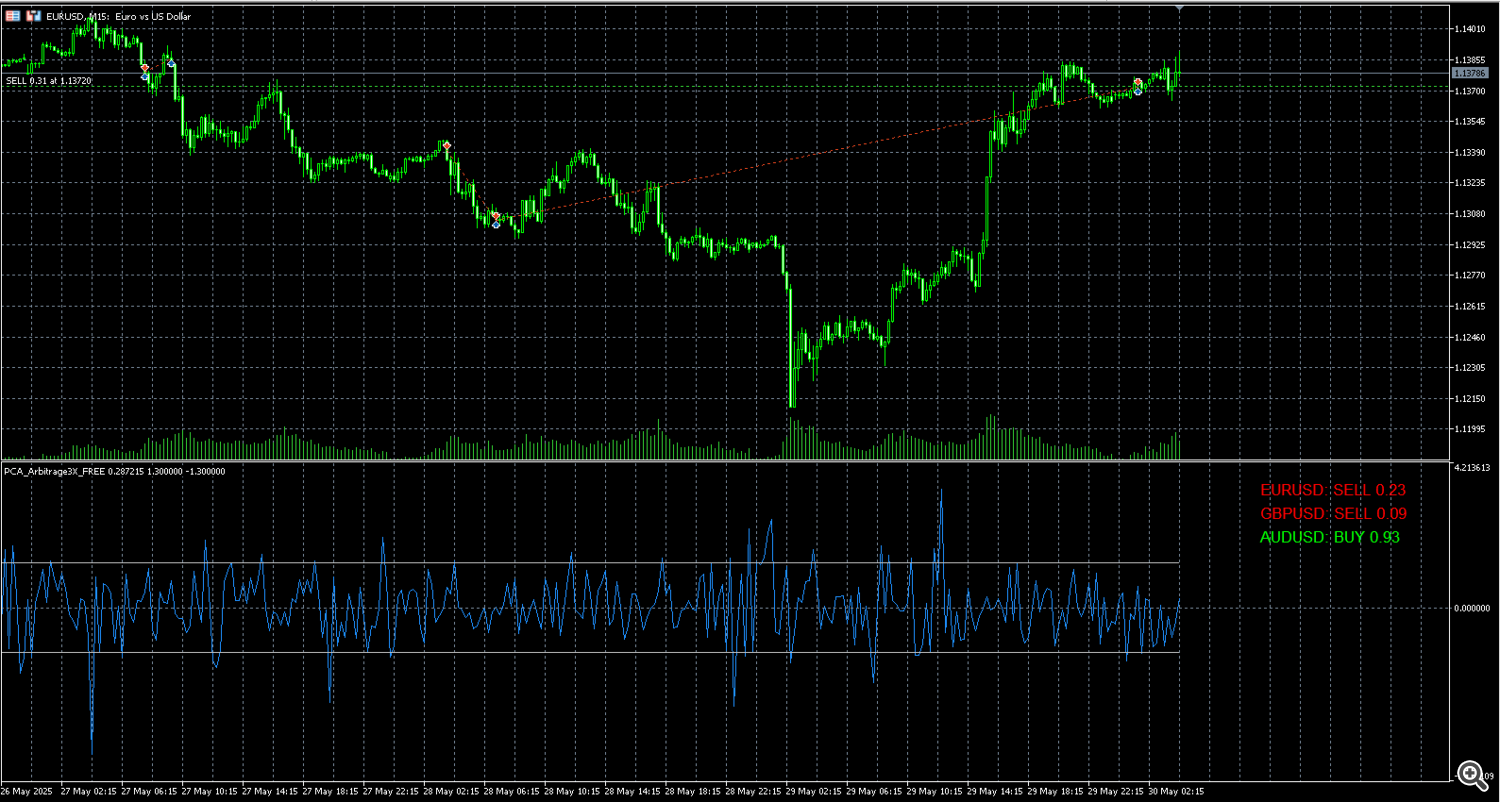
The PCA Method in Practical Use: Guidelines and Criteria for Selecting and Ordering Asset Symbols
How to Properly Specify the Order of Asset Symbols When Using the PCA Method Implemented in the PCA Arbitrage 3X EA Expert Advisor
The Principal Component Analysis (PCA) method has long been recognized as a powerful tool for constructing market-neutral hedging strategies. It enables the analysis of the covariance structure of assets, isolates their contributions to overall trends, and, based on this, forms weight coefficients for position management. This method is implemented in the PCA Arbitrage 3X EA Expert Advisor.
However, in practice, PCA results have proven to be highly sensitive to the order of input data—specifically, the symbols of the assets and their sequence in the Expert Advisor's parameters. If the assets are input into the model in a different order, the resulting eigenvalues, eigenvectors, and calculated weights can vary significantly. This, in turn, affects the position sizing and capital utilization levels.
This brief guide provides recommendations for constructing asset “baskets” for use in trading with PCA-based strategies.
General and Core Recommendation for Choosing a Three-Asset Basket
The most important guideline for selecting a group of three assets is that they should exhibit the highest possible correlation with one another. A typical example would be three major stock indices: S&P 500, NASDAQ, and Dow Jones 30.
In addition to this general recommendation, there's a key principle that many traders and analysts may overlook or creatively reinterpret:
The order of input data is crucial.
PCA does not rearrange assets or determine each asset's contribution independently of its position. All components (eigenvalues and eigenvectors) are returned in the same order as the original input. Therefore, if the order is not fixed, even changing the chart (i.e., changing the first asset) will alter the resulting weight assignments. Experts stress that the input order should be pre-defined and remain consistent to ensure correct interpretation of the PCA results.
Defining a Fixed Order Based on Economic and Market Criteria
Quantitative analysts often recommend selecting the asset order—such as in a basket of currencies like EURUSD, GBPUSD, and AUDUSD—based on criteria such as liquidity, trading volume, volatility, and economic relevance:
-
Base Asset (Symbol 1 - Chart Asset):
Typically, EURUSD is selected due to its high liquidity and status as a benchmark in many strategies. -
Second-Most Significant Asset (Symbol 2):
GBPUSD is often used here, as it maintains strong trading volumes and is closely tied to UK economic indicators. -
Third Asset (Symbol 3):
AUDUSD or another pair with distinct market behavior—such as higher volatility or unique reactions to economic news—can occupy this position.
This structure not only enhances the robustness of PCA outcomes but also ensures consistent interpretation of the components. Each currency's “weight” aligns with its preassigned role rather than a random position in the data array.
Thus, quantitative analysts emphasize that the input order should not be arbitrary or alphabetical but should reflect market-based characteristics: liquidity, volatility, volume, and economic relevance.
Choosing a Fixed Order for Stocks (e.g., COP, CVX, XOM)
When working with stocks, analysts typically rely on several key market criteria to define a consistent order. The most frequently used criteria include:
-
Liquidity and Trading Volume:
Heavily traded stocks provide more reliable data for analysis. The most liquid stock is typically assigned as Symbol 1. -
Market Capitalization:
Companies with larger market caps generally show lower volatility and more stable price movements. For example, if Exxon Mobil (XOM) has the largest capitalization among energy giants, it makes sense to use it as the base asset (Symbol 1). -
Price Volatility and Beta Coefficient:
Some analysts consider standard deviation of returns or the beta coefficient. A stock with higher volatility may add noise to the statistics or, conversely, highlight deviations from the trend. A fixed order can be based on which stock demonstrates more stable behavior. -
Economic Importance and Sector Relevance:
In the energy sector, for instance, analysts often fix the order based on industry leadership. If Exxon Mobil is deemed the sector's leader, it typically takes the first position, followed by Chevron (CVX) and ConocoPhillips (COP)—or the reverse, depending on current market conditions.
Example: Fixed Order for an Energy Stock Basket
Consider the following structure:
-
Symbol 1: XLE ETF
-
Symbol 2: XOM
-
Symbol 3: CVX
Here, the basket is constructed around the XLE ETF, and the individual stock symbols are ranked by their weight within XLE:
-
XLE is the first symbol (i.e., the chart asset where the Expert Advisor is applied).
-
XOM is the stock with the highest weight in the ETF (22.4%).
-
CVX holds the second-highest weight (17.07%).
By fixing the order in this way, you ensure that you are trading the sector basket in accordance with its internal ETF weight structure. This also allows you to track deviations in component vectors—possibly the same ones monitored by XLE’s fund managers.
Conclusion
For equities, experts recommend using a combination of market capitalization, liquidity, volatility, and preliminary statistical analysis to determine a fixed asset order. Doing so preserves the interpretability of PCA-derived weights and helps ensure the strategy remains consistent and robust.



